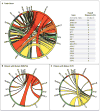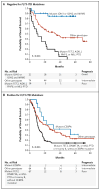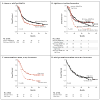Prognostic relevance of integrated genetic profiling in acute myeloid leukemia
- PMID: 22417203
- PMCID: PMC3545649
- DOI: 10.1056/NEJMoa1112304
Prognostic relevance of integrated genetic profiling in acute myeloid leukemia
Abstract
Background: Acute myeloid leukemia (AML) is a heterogeneous disease with respect to presentation and clinical outcome. The prognostic value of recently identified somatic mutations has not been systematically evaluated in a phase 3 trial of treatment for AML.
Methods: We performed a mutational analysis of 18 genes in 398 patients younger than 60 years of age who had AML and who were randomly assigned to receive induction therapy with high-dose or standard-dose daunorubicin. We validated our prognostic findings in an independent set of 104 patients.
Results: We identified at least one somatic alteration in 97.3% of the patients. We found that internal tandem duplication in FLT3 (FLT3-ITD), partial tandem duplication in MLL (MLL-PTD), and mutations in ASXL1 and PHF6 were associated with reduced overall survival (P=0.001 for FLT3-ITD, P=0.009 for MLL-PTD, P=0.05 for ASXL1, and P=0.006 for PHF6); CEBPA and IDH2 mutations were associated with improved overall survival (P=0.05 for CEBPA and P=0.01 for IDH2). The favorable effect of NPM1 mutations was restricted to patients with co-occurring NPM1 and IDH1 or IDH2 mutations. We identified genetic predictors of outcome that improved risk stratification among patients with AML, independently of age, white-cell count, induction dose, and post-remission therapy, and validated the significance of these predictors in an independent cohort. High-dose daunorubicin, as compared with standard-dose daunorubicin, improved the rate of survival among patients with DNMT3A or NPM1 mutations or MLL translocations (P=0.001) but not among patients with wild-type DNMT3A, NPM1, and MLL (P=0.67).
Conclusions: We found that DNMT3A and NPM1 mutations and MLL translocations predicted an improved outcome with high-dose induction chemotherapy in patients with AML. These findings suggest that mutational profiling could potentially be used for risk stratification and to inform prognostic and therapeutic decisions regarding patients with AML. (Funded by the National Cancer Institute and others.).
Figures





Comment in
-
Profiles in leukemia.N Engl J Med. 2012 Mar 22;366(12):1152-3. doi: 10.1056/NEJMe1200409. Epub 2012 Mar 14. N Engl J Med. 2012. PMID: 22417205 No abstract available.
-
Haematological cancer: Turning the clock back on clonal evolution.Nat Rev Clin Oncol. 2012 Apr 3;9(5):245. doi: 10.1038/nrclinonc.2012.50. Nat Rev Clin Oncol. 2012. PMID: 22473100 No abstract available.
-
Genetic profiling in acute myeloid leukemia.N Engl J Med. 2012 Jun 14;366(24):2321; author reply 2321-2. doi: 10.1056/NEJMc1204662. N Engl J Med. 2012. PMID: 22694006 No abstract available.
References
-
- Valk PJ, Verhaak RG, Beijen MA, et al. Prognostically useful gene-expression profiles in acute myeloid leukemia. N Engl J Med. 2004;350:1617–28. - PubMed
-
- Byrd JC, Mrózek K, Dodge RK, et al. Pretreatment cytogenetic abnormalities are predictive of induction success, cumulative incidence of relapse, and overall survival in adult patients with de novo acute myeloid leukemia: results from Cancer and Leukemia Group B (CALGB 8461) Blood. 2002;100:4325–36. - PubMed
-
- Bullinger L, Döhner K, Bair E, et al. Use of gene-expression profiling to identify prognostic subclasses in adult acute myeloid leukemia. N Engl J Med. 2004;350:1605–16. - PubMed
-
- Marcucci G, Haferlach T, Dohner H. Molecular genetics of adult acute myeloid leukemia: prognostic and therapeutic implications. J Clin Oncol. 2011;29:475–86. Erratum, J Clin Oncol 2011;29:1798. - PubMed
Publication types
MeSH terms
Substances
Grants and funding
LinkOut - more resources
Full Text Sources
Other Literature Sources
Medical
Molecular Biology Databases
Miscellaneous
